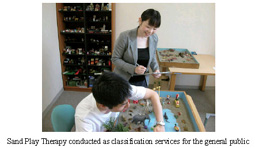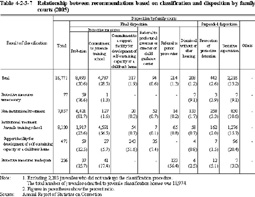| Previous Next Index Image Index Year Selection | |
|
|
2 Classification activities (1) Institutional classification Fig. 4-2-3-6 illustrates the regular flow of classification carried out for juveniles for whom a decision of protective detention (commitment to juvenile classification homes) was made (hereinafter referred to as "institutional classification").
Fig. 4-2-3-6 Flow of institutional classification in juvenile classification homes Classification is determined as to whether to put a juvenile under non-institutional treatment (probation, etc.) or institutional treatment (at juvenile training schools, etc.), based on the results of interview for classification, psychological tests, behavior observation, and medical diagnosis, as well as information from outside. The result of classification is recorded in a classification report along with characteristics of the juvenile's predisposition, factors to lead him to delinquency, and treatment guidelines for rehabilitation, and is sent to a family court as data for a hearing. If an adjudication of protective measures is made, the result is sent to a juvenile training school or a probation office for reference for the treatment.Table 4-2-3-7 shows the relationship between the recommendation based on classification and dispositions by family courts in 2005. Sand Play Therapy conducted as classification services for the general public Table 4-2-3-7 Relationship between recommendations based on classification and disposition by family courts (2005) (2) Classification other than institutional classification a. Non-institutional classification at the request of a family court: Institutional classification is conducted for most cases dealt with by family courts, but non-institutional classification is also conducted by summoning a juvenile to a family court or a juvenile classification home etc. without admitting him or her to a juvenile classification home. In 2005, 512 juveniles were accepted for non-institutional classification (Source: Annual Report of Statistics on Correction).
b. Classification at the request of the relevant agencies of the Ministry of Justice: Types of classification and the number of accepted juveniles in 2005 (Source: Annual Report of Statistics on Correction) were as follows:
- Public prosecutors: Mostly summary expert psychiatric examination on juveniles at the stage of criminal investigation (Four juveniles) - Juvenile training schools: Mostly re-classification on juveniles to review their problems to change their treatment plan (1,919 juveniles) Penal institutions: Mostly classification on juveniles under 16 who were sentenced to imprisonment with or without work in order to contribute to the execution of their sentence - Regional Parole Board and probation offices: Mostly classification of juveniles necessary for parole hearings or the implementation of supervision (6,930 juveniles) c. Classification services for the general public: Classification services for the general public are conducted at the request of citizens, public and private organizations etc. Themes of consultation are wide-ranging, including not only delinquency but also juveniles' character, discipline, and student guidance, etc.
|


